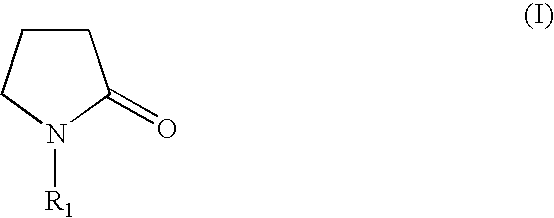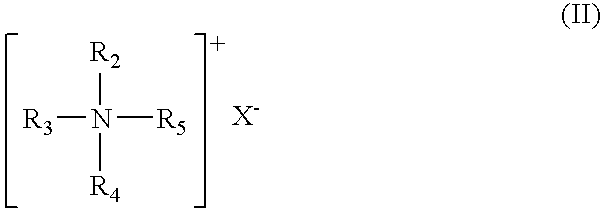Coating material for pattern fineness enhancement and method of forming fine pattern with the same
- Summary
- Abstract
- Description
- Claims
- Application Information
AI Technical Summary
Benefits of technology
Problems solved by technology
Method used
Image
Examples
example 1
[0061] A copolymer of acrylic acid and vinylpyrrolidone [98 g; acrylic acid / vinylpyrrolidone=2:1 (mass ratio)] and tetra(hydroxymethyl)glycoluril (2 g) were dissolved in water (1900 g) to prepare an over-coating agent having the overall solids content adjusted to 5 mass %.
[0062] A substrate was whirl coated with a positive-acting photoresist TDMR-AR2000 (product of Tokyo Ohka Kogyo Co., Ltd.), which contain a novolac resin and a naphtoquinone diazide-type photosensitive agent, and baked at 90° C. for 90 seconds to form a photoresist layer in a thickness of 1.3 μm.
[0063] The photoresist layer was exposed with a laser exposure unit (Nikon NSR-2205il4E of Nikon Corp.), subjected to heat treatment at 110 ° C. for 90 seconds and developed with an aqueous solution of 2.38 mass % TMAH (tetramethylammonium hydroxide) to form photoresist patterns which defined hole patterns with an each diameter of 411.8 nm (i.e., the spacing between the photoresist patterns was 411.8 nm).
[0064] Then abov...
example 2
[0065] A copolymer of acrylic acid and vinylpyrrolidone [98 g; acrylic acid / vinylpyrrolidone=2:1 (mass ratio)] and tetra(hydroxymethyl)glycoluril (2 g) were dissolved in water (400 g) to prepare an over-coating agent having the overall solids content adjusted to 20 mass %.
[0066] A substrate was whirl coated with an excimer laser-ready photoresist composition DP-TFOLOPM (product of Tokyo Ohka Kogyo Co., Ltd.), and baked at 130° C. for 150 seconds to form a photoresist layer in a thickness of 3.0 μm.
[0067] The photoresist layer was exposed with a laser exposure unit FPA3000EX3 (Canon Inc.), subjected to heat treatment at 120° C. for 150 seconds and developed with an aqueous solution of 2.38 mass % TMAH to form photoresist patterns which defined hole patterns with an each diameter of 202.2 nm (i.e., the spacing between the photoresist patterns was 202.2 nm).
[0068] Then above-described over-coating agent was applied onto the substrate including the hole patterns and subjected to heat...
example 3
[0069] A copolymer of acrylic acid and vinylpyrrolidone [98 g; acrylic acid / vinylpyrrolidone=2:1 (mass ratio)] and tetra(hydroxymethyl)glycoluril (2 g) were dissolved in water (400 g) to prepare an over-coating agent having the overall solids content adjusted to 20 mass %.
[0070] A substrate was whirl coated with an electron beam-ready photoresist composition EP-TF004EL (product of Tokyo Ohka Kogyo Co., Ltd.), and baked at 150° C. for 300 seconds to form a photoresist layer in a thickness of 2.0 μm.
[0071] The photoresist layer was exposed to be traced with an electron beam (EB) lithography equipment (HL-800D of Hitachi, Ltd.), subjected to heat treatment at 140° C. for 300 seconds and developed with an aqueous solution of 2.38 mass % TMAH to form photoresist patterns which defined hole patterns with an each diameter of 234.8 nm (i.e., the spacing between the photoresist patterns was 234.8 nm).
[0072] Then above-described over-coating agent was applied onto the substrate including t...
PUM
 Login to View More
Login to View More Abstract
Description
Claims
Application Information
 Login to View More
Login to View More - R&D
- Intellectual Property
- Life Sciences
- Materials
- Tech Scout
- Unparalleled Data Quality
- Higher Quality Content
- 60% Fewer Hallucinations
Browse by: Latest US Patents, China's latest patents, Technical Efficacy Thesaurus, Application Domain, Technology Topic, Popular Technical Reports.
© 2025 PatSnap. All rights reserved.Legal|Privacy policy|Modern Slavery Act Transparency Statement|Sitemap|About US| Contact US: help@patsnap.com



